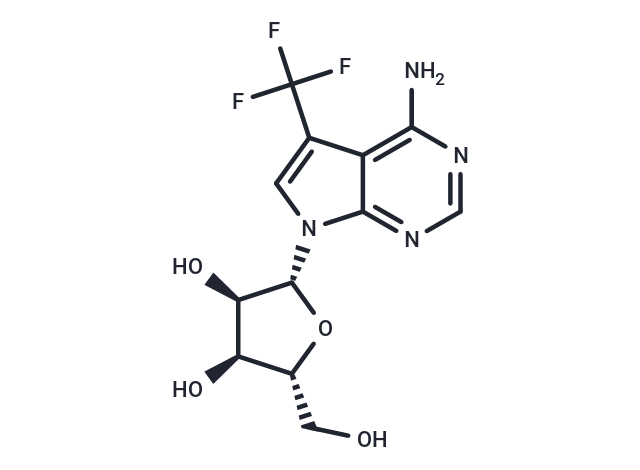Shopping Cart
- Remove All
 Your shopping cart is currently empty
Your shopping cart is currently empty

Trifluoromethyl-tubercidin (TFMT) inhibits host MTr1 and suppresses virus replication. TFMT inhibits MTr1 through interaction at its S-adenosyl-l-methionine binding pocket to restrict influenza virus replication. TFMT was effective in inhibiting viral replication in mice, displayed little toxicity.

| Pack Size | Price | Availability | Quantity |
|---|---|---|---|
| 1 mg | $47 | In Stock | |
| 5 mg | $108 | In Stock | |
| 10 mg | $196 | In Stock | |
| 25 mg | $459 | In Stock | |
| 50 mg | $827 | In Stock | |
| 100 mg | $1,490 | In Stock |
| Description | Trifluoromethyl-tubercidin (TFMT) inhibits host MTr1 and suppresses virus replication. TFMT inhibits MTr1 through interaction at its S-adenosyl-l-methionine binding pocket to restrict influenza virus replication. TFMT was effective in inhibiting viral replication in mice, displayed little toxicity. |
| In vitro | The median inhibitory concentration (IC50) for trifluoromethyl-tubercidin against IAV infection was 0.30 μM, and no notable in vitro toxicity was observed in the range of effective concentrations, as measured with water-soluble tetrazolium (WST)–8 cell viability assay. Trifluoromethyl-tubercidin treatment also greatly inhibited IAV replication when administered 3 to 4 hours after infection. Trifluoromethyl-tubercidin showed inhibitory activity in the IAV-infected mouse cell line LA-4, albeit with lower potency (IC50 = 7.7 μM) than in human cells[1]. |
| In vivo | Trifluoromethyl-tubercidin treatment at 2 days after infection with IAV. At this point, NP and PB2 mRNA levels were significantly reduced by trifluoromethyl-tubercidin treatment in mouse lungs, indicating that the trifluoromethyl substitution of tubercidin reduces in vivo toxicity to levels we could not detect, but retains anti-IAV efficacy[1]. |
| Molecular Weight | 334.25 |
| Formula | C12H13F3N4O4 |
| Cas No. | 1854086-05-7 |
| Smiles | O[C@H]1[C@H](N2C=3C(C(C(F)(F)F)=C2)=C(N)N=CN3)O[C@H](CO)[C@H]1O |
| Relative Density. | 1.96 g/cm3 (Predicted) |
| Storage | Powder: -20°C for 3 years | In solvent: -80°C for 1 year | Shipping with blue ice. | |||||||||||||||
| Solubility Information | DMSO: 3.34 mg/mL (9.99 mM), Sonication is recommended. | |||||||||||||||
Solution Preparation Table | ||||||||||||||||
DMSO
| ||||||||||||||||

Copyright © 2015-2025 TargetMol Chemicals Inc. All Rights Reserved.